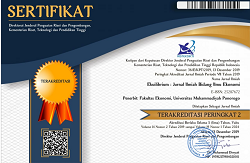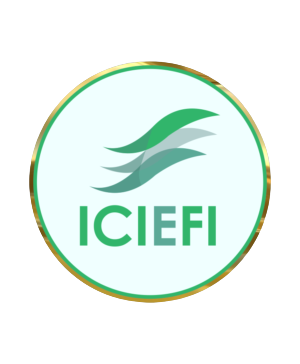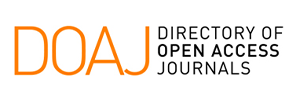Analysis of Local Tax Efforts in Supporting Increasing Ponorogo Regency’s Original Local Government Revenue
DOI: 10.24269/ekuilibrium.v16i2.2021.pp164-175
Abstract
This research was conducted at the Agency for Revenue, Financial Management, and Regional Assets of Ponorogo Regency, which aims to make an analysis of local tax efforts (tax effort) in supporting the increase in Ponorogo Regency's Original Local Government Revenue. This study uses analysis methods of local tax elasticity, analysis of local tax contributions, analysis of local tax effectiveness, and analysis of local tax efforts. The final results of this study showed that the average elasticity of local taxes during 2014-2020 is 2.30, meaning that the elasticity of local taxes in Ponorogo Regency falls within the elastic criteria. This shows the elasticity relationship between the growth rate of local taxes and the growth of GDP towards Local Revenue. The average rate of local tax contributions during 2013-2020 was 26.91% with moderate criteria. This means that local tax receipts during 2013-2020 are not the largest source of Local Revenue, as it only provides income to Local Revenue of 26.91% on average during the research year. The average rate of effectiveness of local taxes during 2013-2020 was 116.84% with very effective criteria. This means that local tax receipts during 2013-2020 illustrate the ability of local governments in realizing local revenues with targets set based on the potential of the regional rill. The average tax effort for 7 years (2014-2020) is 1.89%. This shows that the level of local tax efforts in Ponorogo regency has decreased over the last 7 years. The decrease in the level of tax effort occurs due to the decrease in GDP. Based on the results of the analysis, the Regional Government of Ponorogo Regency through the Original Local Government Revenue, Financial and Asset Management Agency can continue to improve the local tax collection mechanism because it is proven to be able to provide a large contribution to Original Local Government Revenue.
Keywords
References
- Bastian, Indra. (2011). Sistem Akuntansi Sektor Publik. Jakarta: Salemba Empat.
- Davey, K.J. (1988). Pembiayaan Pemerintah Daerah, Praktek-Praktek International dan Relevansinya bagi Dunia Ketiga. Jakarta: UI Press.
- Indonesian Ministry of Home Affairs No. 690.900.327 the Year 2006
- Djumhana, Muhammad. (2007). Pengantar Hukum Keuangan Daerah. Bandung: Citra Aditya Bakti.
- Retrived from Dppkad.ponorogo.go.id on 26/11/2020
- Asmawanti D., Elvandari N., and Baihaqi. (2016). Analisis Tax Effort, Efektivitas, Kontribusi dan Pertumbuhan Pajak Daerah Kota Bengkulu Tahun 2011-2014. Jurnal Akuntansi ISSN 2303-0356 Vol. 4, No.1, Februari 2016, 33-50. Fakultas Ekonomi dan Bisnis Universitas Bengkulu.
- Fawaidurrohman, A., N. S. Askandar, dan Afifudin. (2019). Analisis Kontribusi Pendapatan Asli Daerah terhadap APBD Kabupaten Bangkalan Tahun 2014-2018. E-JRA Vol. 08, No. 11, 87-103.
- Guritno. (1992). Kamus Ekonomi. Jakarta: Erlangga.
- Halim, Abdul. (2004). Akuntansi Sektor Publik: Akuntansi Keuangan Daerah. Edisi Revisi. Jakarta: Salemba Empat.
- Halim, Abdul. (2007). Akuntansi Keuangan Daerah. Jakarta: Salemba Empat.
- Halim, A., Kusufi, Syam M. (2014). Akuntansi Sektor Publik: Teori, Konsep, dan Aplikasi. Jakarta: Salemba Empat.
- Handoko P, Sri. (2013). Analisis Tingkat Efektivitas Pajak Daerah sebagai Sumber Pendapatan Asli Daerah Kota Pontianak. JEDA: Jurnal Ekonomi Daerah, Volume 1(1).
- Kirchler, E., Hoelzl, E., and Wahl, I. (2008). Enforced Versus Voluntary Tax Compliance: The Slippery Slope Framework. Journal of Economic Psychology, 29(2), 210-225
- Karyawan, Lalu. (2002). Efisiensi, Efektivitas dan Elastisitas Pajak Hotel dan Restoran di Kota Mataram Nusa Tenggara Barat. Tesis. Yogyakarta: Pasca Sarjana MEP UGM.
- Lohonauman, I. L. (2016). Analisis Efektivitas Pemungutan Pajak Daerah dalam Meningkatkan Pendapatan Asli Daerah di Kabupaten Sitaro. EMBA, Vol. 4, No. 1, 172-180.
- Mahmudi. (2010). Analisis Laporan Keuangan Pemerintah Daerah. Yogyakarta: Sekolah Tinggi Ilmu Manajemen.
- Mahmudi. (2010). Manajemen Keuangan Daerah. Jakarta: Erlangga.
- Mahmudi. (2016). Analisis Laporan Keuangan Pemerintah Daerah. Edisi Ketiga. Yogyakarta: Unit Penerbit dan Percetakan Sekolah Tinggi Ilmu Manajemen YKPN.
- Mardiasmo. (2016). Perpajakan Edisi Terbaru 2016. Yogyakarta: ANDI.
- Mulyanto. (2007). Pengembangan dan Pengukuran Indikator Pembangunan Daerah di Era Otonomi dan Desentralisasi. Region, Vol. 2, No. 1, 43-52.
- Patra Ls, A. Dahri Adi. (2016). Analisis Upaya Pajak Daerah (Tax Effort) dalam Mendukung Peningkatan PAD Kota Palopo. Prosiding Seminar Nasional Volume 03, Nomor 1. Sekolah Tinggi Ilmu Ekonomi Muhammadiyah Palopo.
- Pohan, Chairil Anwar. (2014). Manajemen Perpajakan. Yogyakarta: PT. Gramedia Pustaka Utama.
- Mahi, Raksaka. (2005). Peran Pendapatan Asli Daerah di Era Otonomi. Jurnal Ekonomi dan Pembangunan Indonesia. Vol.VI No.1, 39-49.
- Sugiyono. (2015). Metode Penelitian Bisnis. Bandung: Alfabeta.
- Undang-Undang Nomor 9 Tahun 2015 tentang Pemerintah Daerah, Pendapatan Asli Daerah (PAD).
- Undang-undang Nomor 28 Tahun 2009 tentang Pajak Daerah dan Retribusi Daerah
- Undang-undang No. 33 Tahun 2004 tentang Perimbangan Keuangan Antara Pemerintah Pusat dan Pemerintah Daerah
- Yunanto, Lilik. (2010). Analisis Upaya Pajak, Efisiensi dan Efektivitas dan Elastisitas Pajak Hotel di kabupayen Klaten. Skrispsi. Universitas Sebelas Maret.
Refbacks
- There are currently no refbacks.

This work is licensed under a Creative Commons Attribution-ShareAlike 4.0 International License.














